


 |

|
 |
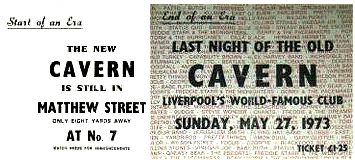 |
The Cavern was told that it would have to close until the cesspit was cleared
and a new drainage system built with new toilets. The cost of this work
was estimated at £3,500, a fantastic amount of money at the time.
Closure was temporarily delayed when a company on the ground floor allowed
The Cavern's customers to use their toilets. However, it was doomed from
the start - the company became increasingly horrified by the mess being
made and the Cavern staff grew tired of having to clean the toilets at midnight
after the evening session - and so arrived the end of an era. It wasn't just the toilet facilities that led to the closure of The Cavern - the failure of its recording studio and records was also a contributing factor. Another was that the club was still unlicensed and, with other clubs around the area providing licensed premises, The Cavern's profitability suffered. It could also be said that The Cavern's main attraction had gone. With The Beatles no longer there, most of the other bands that played at the club could also be seen elsewhere. Times were a-changing and the music listened to by the youngsters was going through a radical transformation as 1966 turned into 1967, a definitive year for music. |
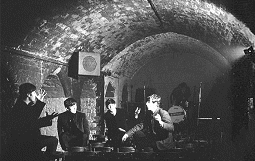 |
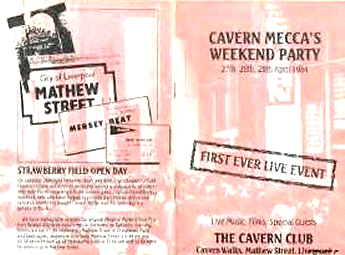 |
The
'new' Cavern was a licensed venue and, hence, had a much older clientele.
The old days of kids bunking off school to attend lunchtime shows had gone
forever - The Cavern was now for grown-ups. As the kids left so did the
soft drinks and crisps, the replacement coming in the form of drugs. By
the end of the 60's and the beginning of the 70's a 'drug culture' had swept
the nation and the developed world as we know it. Under the guise of 'love
and peace' the hippie was born and so, too, was LSD. The emergence of this
new sub-culture spread to the shores of Liverpool and thence to the smoke-filled
dance floors of The Cavern club. For some, the early 70's was a great period for The Cavern with the likes of Wishbone Ash, Thin Lizzy, Supertramp and Judas Priest playing there and the club continued to be popular. During the early Seventies the club acquired a new owner, Roy Adams, but the same old problems came back. The underground railway was to be extended and The Cavern's site was needed for an extraction duct. The local council served the club with a compulsory purchase order which was impossible to fight and the decision was made to close The Cavern for the final time. On 27th May 1973 the bulldozers moved in and Liverpool's most famous venue was buried under demolition rubble. After the extraction duct was completed, the remainder of the site was levelled and the now waste land became a temporary car park. Roy Adams decided to open another club, across the road from The Cavern's original site, in a group of warehouses called The Fruit Exchange. The new club was called first 'The New Cavern', later 'Cavern Mecca', and held over 2,000 people. Local sculptor Arthur Dooley put a representation of The Beatles on the outside wall with the inscription 'Four lads who shook the world' - a work of art which is still in place to this day. Following the tragedy of John Lennon's death the statue has been used as a focal point for fans to leave their flowers and poems of remembrance. |
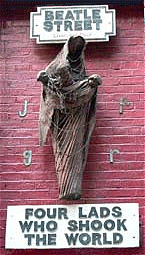 |
 |
His idea was to build a shopping centre with a special theme in remembrance
of The Beatles and, more importantly, he wanted to build a 'new' Cavern
club. Royal Life, (part of the Royal Insurance group who merged with SunAlliance
in 1996 to become Royal & SunAlliance) who had very strong historical links
with the city since 1845, were approached as potential backers for the ambitious
project. These are not to be confused with Royal Liver Assurance whose main
company headquarters is the distinctive Liver Building, an imposing edifice
that is a feature of Liverpool's Mersey waterfront skyline. Meetings were followed by more meetings and eventually permission was finally given for the go ahead. The original plan was to rebuild the old Cavern as it was thought that the underground club would still be intact below the hastily-built car park above it. Unfortunately, on careful examination by structural engineers, it was discovered that the club's ceilings and general fabric had collapsed so the original Cavern could never be resurrected. The area above the club was also important as this was required for the building of the shopping centre. As portions of the land were owned by Mersey Railways, having been acquired during the original demolition of The Cavern in 1973, it was decided to scrap plans to rebuild the original Cavern and build a replica Cavern underneath the new shopping centre to be sited further down Mathew Street. For this task it was decided to re-use bricks from the now-excavated original Cavern. Over 15,000 bricks from the old Cavern were used in the reconstruction and, over the weeks of building, quite a few disappeared as many local people took away their own little piece of rock history but 5000 of the original bricks were saved and sold off by the Royal Life company in 1983 for £7.00 each. A plaque certifying their authenticity (see left) was glued to each brick with the proceeds being donated to a local charity. All of the bricks were sold out within the first year and in the late 1980s one was re-sold at auction for over £500 by Sotheby's. |
The new Cavern is a mock-up of the old, smaller than the original, although it does fill 50% of the original site and retains its original postal address. Other differences are that it is deeper set than the original and the stage is placed to the left as you enter down the stairs (it was facing you in the original) and the original band room is placed at the back of the stage as opposed to the side in the original. The new Cavern also contains a bar area with a new room to one side that contains a large purpose-built stage where many local and international acts have performed, most notable being Paul McCartney's triumphant return to the site of The Cavern in 1999. The large warehouses that once stood on Mathew Street now contain a vast shopping centre that contains several floors of offices, a Beatles theme pub, a restaurant called Abbey Road and over thirty shops selling everything from designer clothes to confectionery and Beatles souvenirs. The whole of the redeveloped Mathew Street was renamed Cavern Walks and the surrounding area is now known as the Cavern Quarter. Even though the original no longer exists there are, in fact, still two 'Caverns' in Liverpool. To see the other one, take a journey to Liverpool's seafront and visit The Albert Dock complex which is the home of 'The Beatles Story', a fascinating multimedia exhibition devoted to the Fab Four. Although not a museum in the strictest sense, visitors are taken on a journey back into the past to relive the great days of The Beatles in visual and audio displays that recreate the sights and sounds of The Beatles rise to world wide fame. There, holding pride of place, is a recreation of the centre arch of the first Cavern club containing the stage and band room. The original site may have no lasting formal recognition with the echoes of its past finally having been laid to rest, but in the hearts and minds of local people and Cavern dwellers everywhere, the sounds that echoed from its older brother's walls will live on forever in the memories and imagination of all who visit this tiny cellar in Mathew Street each year. |
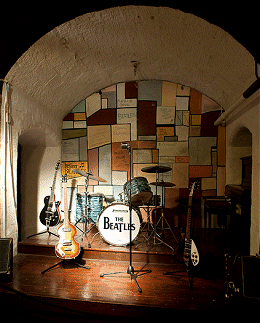 |

|
|
All
Original Material Copyright SixtiesCity
Other individual owner copyrights may apply to Photographic Images |